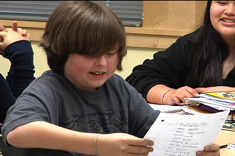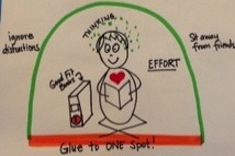Last October, my family got a puppy.
I have extensive experience with dogs from my childhood and pre-parenthood days. I know a few things about training a puppy into a likable, well-mannered, amiable dog. My children, on the other hand, have no dog experience. Zero.
Which means I’m training the dog, but I’m also training my children how to train the dog.
What emerged as our biggest challenge was not, to my surprise, unexpected yellow spots on the carpet or begging at the table. Instead, it was how my kids overused the pup’s name. Roxie, come here. No, Roxie. Roxie, please come here. Roxie Roxie Roxie, come here, Roxie, and Roxie, sit. Sit, Roxie, come here, sit. Roxie, sit, come here, Roxie, ROXIE!!
Watching them repeatedly shout, squeal, and holler her name, I could actually see the moment Roxie stopped listening. She would start whirling and twirling, watching only for some sort of reward—a treat, a walk, some object thrown into the air for retrieval.
“Say her name only when you really need her to hear you,” I explained to my kids. “Our goal is this: Her name should always and only be associated with a specific action we need from her. If we use her name sparingly, she will always hear it and know there is a reason to pay attention.” I talked to them about other ways to get her attention—touch, alternate sounds, repeated hand commands, and so on.
I understand their instinct to overuse the pup’s name. It’s a general assumption that by repeating someone’s name, again and again and again, we will grab and sustain their focus. I once had a boss who’d been told, somewhere along the way, to use a listener’s name frequently. Here’s the thing, Jennifer, he said to me during our annual goals meeting. We have a great opportunity, Jennifer, to do some really great things here. If you sit down, Jennifer, and really think about your goals, we can work together to create something really measurable and effective. Right, Jennifer? There’s nothing more powerful than collaboration, Jennifer.
Every time I heard him use my name—the formal and rarely used version of my name, no less—it was like an unexpected jolt. Instead of engaging me, hearing my name used over and over again felt condescending and irritating. My natural response? To stop listening and start daydreaming.
Overusing anyone’s name dulls and eventually eliminates its effectiveness. It disengages the listener, and without a listener, there can be no two-way communication.
The same is true of students in our class. We use their names a lot—too often, probably. Whether it is for classroom management purposes, developing a rapport with students, or helping a student maintain focus, we would do well to consider other ways to keep our students engaged in their work.
Bren
Last September, just after the start of school, I observed a lesson from a very accomplished reading teacher, Jill, who worked with small groups of students who needed decoding and comprehension practice. One student, Bren, a second grader, was known for his short attention span. He was a delightful boy, smart and creative, but found so many distractions in the room that redirecting him was an ongoing task. Jill used his name to call him back to the purpose of the lesson multiple times. It worked, and it worked well. I said as much as we debriefed after the lesson. “You use his name to effectively draw his attention back to you,” I said, meaning it as a compliment. She took the acknowledgment with a gracious “Thank you,” followed by, “But . . .”
I waited.
“I’m overusing his name,” she declared. “It won’t be long before it doesn’t work at all. I’ll soon have to find other tricks to keep him engaged.”
I was impressed with her forward planning, and told her as much. “Come back in a few weeks,” she said. “I betcha he will have already stopped responding to the use of his name.”
She was dead on. By my count, he responded to the use of his name only about half the time. The teacher winked at me as I left the room; just as she’d predicted, he’d stopped hearing her. But when we discussed it in the lounge later that day, she was ready. “I have a bunch of other ideas for cues to engage his attention,” she said. She invited me to come back as often as I’d like to see it evolve.
Each time I visited to see Jill work with Bren, I was blown away by the intentionality of her choices in substituting something else for his name. Here is a sampling of things I saw:
An affectionate nickname. Or three. She had about three different names she used beyond Bren’s given one, and she rotated their use to keep them fresh. She’d asked for his approval with each one, lest she use a nickname he didn’t enjoy or one that he didn’t think expressed her fondness for him. She called him “B,” “Blue” (for his lovely blue eyes), and “Captain Starburst” (for his favorite candy). She also used the occasional “Buddy,” “Dude,” and “Sweetheart.”
Physical cues, movements, or changes in location. Several times during each lesson, Jill lightly touched his hand or forearm. She shifted her seat to a different location or asked him to stand and rock back and forth during particular activities. Each time, it brought his focus back to her and the lesson.
Timers and fidgets. There is nothing new here; having a visual timer or the use of objects to jiggle, shuffle, and squeeze are conventional strategies that work well with students who struggle with attention. Timers with visual countdowns are my favorites, because the teacher can easily draw attention to them with wordless cues to the student—a pointed finger, a tap on the timer base, even the lift of an eyebrow and quick glance toward the timer.
Sounds. Jill had a string of sleigh bells on her desk she shook every now and then. I’ve seen teachers use muted whistles, a harmonica, music on iTunes, or other auditory cues to bring a student or class back to attention.
Visual cues. Jill created a small group of pictorial depictions of physical actions (“read,” “write,” “respond,” “think”) and affixed them to a Velcro base. When she pulled a word off the base, the crrrrssshh sound in itself drew Bren’s attention, as did the picture reminding him to stay on task.
Bren had a very successful experience in Jill’s room, in large part because of her willingness to diversify the strategies she used to keep his attention. Jill still used Bren’s name as a tool, but she had many other effective tricks, too, and she was mindful in how she rotated their use. Bren never stopped listening to her, because he never got sick of hearing his own name.






